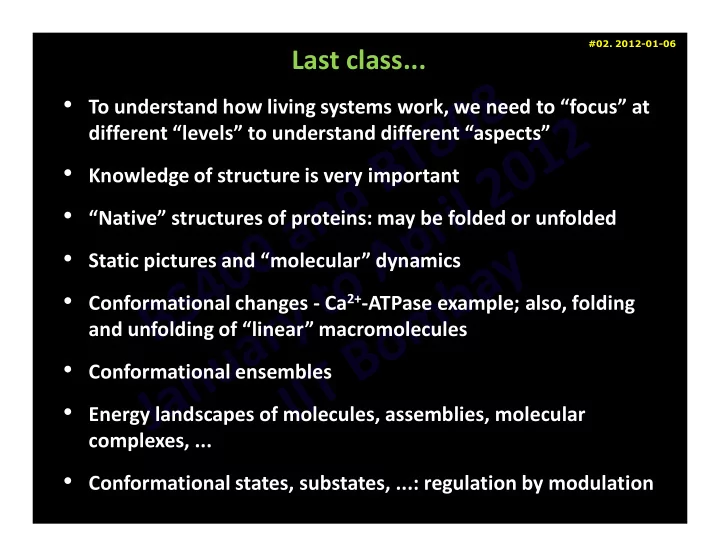

��������������� Last class... • To understand how living systems work, we need to “focus” at different “levels” to understand different “aspects” • Knowledge of structure is very important • “Native” structures of proteins: may be folded or unfolded • Static pictures and “molecular” dynamics • Conformational changes - Ca 2+ -ATPase example; also, folding and unfolding of “linear” macromolecules • Conformational ensembles • Energy landscapes of molecules, assemblies, molecular complexes, ... • Conformational states, substates, ...: regulation by modulation
��������������� “Energetics” perspective Conformation “a” Conformation “b” Unfolded Folded (protein, DNA, RNA) Monomers (homo/hetero) Oligomer(s) (protein, lipid) A + B A·B (binding) ∆ G = ∆ ∆ ∆ ∆ ∆ ∆ ∆ H – T ∆ ∆ ∆ ∆ S
��������������� Enthalpy and entropy ∆ ∆ ∆ ∆ G = ∆ ∆ ∆ ∆ H – T ∆ ∆ ∆ ∆ S entropy changes enthalpy changes (mainly: non-covalent interactions)
��������������� Outline 1. Sequence - {Folding} - Structure - Dynamics - Function paradigm 2. Molecular structure 3. Steric effect or hard-sphere approximation 4. Non-covalent interactions 5. Entropy 6. Stability and folding of proteins ∆ G = ∆ ∆ H – T ∆ ∆ S ∆ ∆ ∆ ∆ ∆ ∆ ∆ 7. Lipids 8. Binding
��������������� Outline 1. Sequence - {Folding} - Structure - Dynamics - Function paradigm: perspective for the course 2. Molecular structure: representation, conformational changes, conformational ensembles, conformer selection 3. Steric effect or hard-sphere approximation: preferred (allowed) versus not-preferred (disallowed) conformations; application to monosaccharides and peptides; Ramachandran map ... continued
��������������� 3D structure at atomic level X-ray crystallography Has made the most substantial contribution Provides static picture NMR spectroscopy Provides dynamic picture Size-limit is an issue (currently, up to 40-50 kDa) Molecular motions of 670 kDa 20S proteasome Nature 2007 445:618 3D structure has been determined by both the methods for some proteins: structure is not different
��������������� Protein Data Bank www.rcsb.org
��������������� Nucleic Acid Database http://ndbserver.rutgers.edu/
��������������� Cambridge Crystallographic Database www.ccdc.cam.ac.uk/
��������������� Representing molecules 1. Cartesian coordinates - most widely used 2. Internal coordinates The two are inter-convertible
��������������� Representing molecules: Cartesian coordinates � � � � � � � � � � � � � (x,y,z) coordinates for each atom
��������������� Cartesian coordinates
��������������� Cartesian coordinates in Šunits Atom name X,Y,Z coordinates Amino acid residue Amino acid number name
��������������� Internal coordinates Also referred to as the “geometry” of the molecule 1. Bond length (defined between two atoms) 2. Bond angle (defined between three atoms) 3. Torsion (or dihedral) angle (defined with respect to four atoms) generally in Å units, some times in nm
��������������� Bond length � ��� ���� ��� ���� � ��� ���� ��� ���� � � � ��� ���� ��� ���� � � ��� ���� � � ��� ���� � ��� ���� ��� ���� ��� ���� ��� ����
��������������� Bond angle � � � � ������� � �� � ��� � �� � ��� � � �
��������������� Torsion angle Torsion angle: measure of rotation around a (single) bond � � � � �� !�� "#!$ %!%!�� � $&�� $#'�� ��(���(��� � � � �� � �� �� �� !�� �� "#!$ %!%!�� $&�� $#'�� ��(���(���
��������������� Torsion angle If C1, C2, C3 and C4 are four consecutively bonded atoms, then the torsion angle is the angle between the normal to the plane containing the atoms C1, C2, C3 and the normal to the plane containing the atoms C2, C3, C4 � �� !�� � "#!$ %!%!�� � � $&�� $#'�� ��(���(��� � � �� � �� �� � �� !�� �� � "#!$ %!%!�� $&�� $#'�� ��(���(���
��������������� Torsion angle )#$ $%#!� *#+$�$&��*#!��*�$,��!� $#'����� !���� -$#'����'#.���,%$&����/�"$�$#� $#'��� �����������%�$ !"��. �%�� � � -$#'����,%$&����/�"$�$#� $#'����(���� �%�$ !"�����' %!�$&��� '� � � torsion: the twisting or wrenching of a body by the exertion of forces tending to turn one end or part about a longitudinal axis while the other is held fast or turned in the opposite direction (from the Merriam-Webster online dictionary)
��������������� Torsion angle conventions �"�%/������0��#�1"%�2 ��#"8,%����#$ $%#!6� /#�%$%.��. �+�� �#+!$��"�#"8,%��� �#$ $%#!6�!�� $%.�� 3 4%' ��5� . �+�� ��/ � $����� ����1$� !�2 ) !��6���$#�����17�#���2
��������������� Torsion angle nomenclature �������������� 1 �� 2 ��������� � ��� �� ����������� 1� �� 2 ����������� 17 �� 2 ��� �� ������� ������� ��� �� ���� ��� ������������ 17 �� 2 ������������ 1� �� 2 ���� ��� ��� ������������ ��������������� 1 �� 2
��������������� Torsion angles and Newman projection diagrams -, 5� � ;�#'�$&�� � � .%�,�� �� � �� �� � :#, ���� � $&�� �� � .%�,�� � �� �� � �� 9%�,%!�� �#!�� $&���� → → ���*#!� → →
��������������� sp 3 - sp 3 torsion – possible definitions � ����������� ����������� ����������� ����������� � � �� ����������� ����������� � � �� �� � �� � � �� �� � �� ����������� ����������� �����������
��������������� Relationship between different definitions -, 5� � ;�#'� $&�� � � �� � .%�,�� �� �� � � :#, ���� �� � $&�� � �� �� .%�,�� � �� 9%�,%!�� �#!��$&�� ��������������������������< ��� �� → → ���*#!� → → ��������������������������7����
��������������� Newman projection diagram: sp 2 - sp 3 torsion :#, ���� � $&�� .%�,�� � � � �� �� -, 5� � ;�#'�$&�� .%�,�� � � �� � � � �� � 9%�,%!�� �#!��$&�� � → → ���*#!� → →
��������������� Newman projection diagram: sp 2 - sp 2 torsion :#, ���� $&�� � .%�,�� �13�2 � � � �� � � � � -, 5� ;�#'�$&�� � .%�,�� � �� � 9%�,%!�� �#!��$&�� � → → ��*#!� → →
��������������� Newman projection: single substituent on a sp 3 9%�,%!�� �#!�� :#, ���� $&��.%�,�� $&���� → → �=�*#!� → → �� � N-Acetylmuramic acid (NAM) -, 5�;�#'� $&��.%�,�� 3� �� ��� �� �� �= 3� � ��� β β -D-Glucose with N-Acetyl group, instead β β of –OH, at C2 and D-lactic acid at O3
Recommend
More recommend